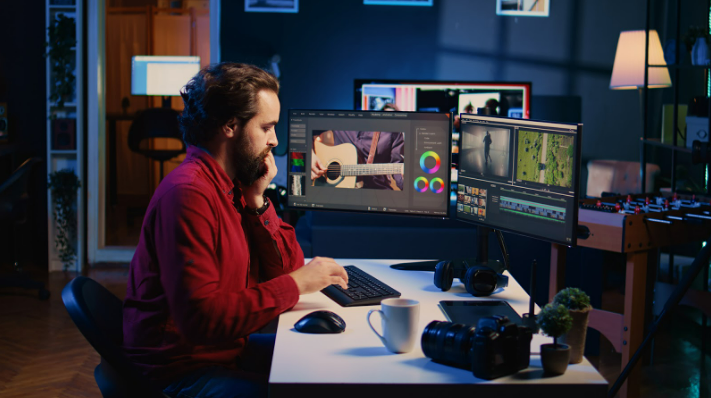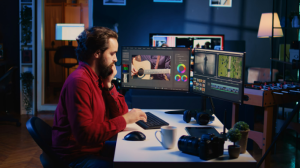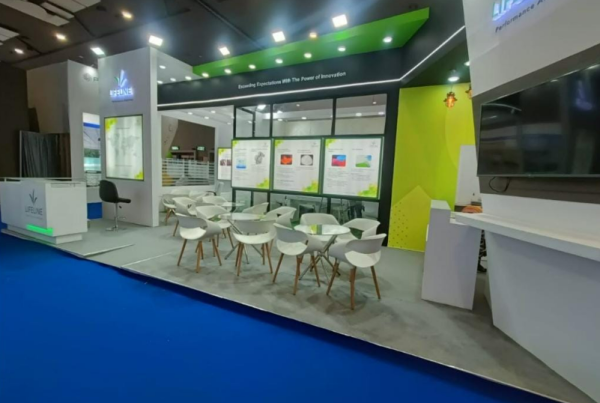What is New Media Design?
Think of it as the bridge between traditional design principles and the ever-expanding digital landscape. New Media Designers create visual experiences for a variety of platforms – websites, apps, social media, animations, and more. They are storytellers who use their design skills to craft engaging and interactive content.
Why New Media Design?
- Dynamic and Diverse:
The field is constantly evolving, offering a multitude of specializations to explore, from UX/UI design to motion graphics and beyond. There’s a niche for every creative passion. - In-Demand Skills:
With the digital age upon us, the need for skilled New Media Designers is booming. You’ll be at the forefront of shaping how users interact with technology. - Creative Problem-Solving:
It’s not just about making things look pretty. You’ll delve into user psychology, information architecture, and cutting-edge tools to create solutions that are both beautiful and functional.
So, you’re interested? Here’s how to get started:
- Build Your Foundation:
A strong understanding of design principles like color theory, typography, and composition is essential. Consider taking online courses or attending workshops to solidify your design basics. - Explore the Tools:
Dive into industry-standard design software like Adobe Creative Suite (Photoshop, Illustrator, After Effects) and Figma for user interface (UI) and user experience (UX) design. - Find Your Niche:
The world of New Media Design is vast. Experiment with different areas like animation, web design, or social media graphics to discover what ignites your passion. - Create a Killer Portfolio:
Your online portfolio is your gateway to the industry. Showcase your best work, highlighting your design process and how you tackled specific challenges. - Stay Insatiable:
The world of New Media Design is constantly evolving. Stay updated on the latest trends, software advancements, and design thinking through online resources, attending conferences, and following design influencers.
Graduates navigate across disciplines like art, science, technology, design, and philosophy, enabling them to work in ambiguous situations and continually inform their practice through research.
- User Interface (UI) Design
Focuses on creating visually appealing and user-friendly interfaces for digital products such as websites, mobile apps, and software. UI designers collaborate with UX designers and developers to ensure that the interface meets user needs and design standards. - User Experience (UX) Design
Involves designing the overall experience of a user when interacting with a digital product. UX designers conduct user research, create user personas, design wireframes and prototypes, and collaborate with UI designers and developers to create seamless and intuitive user experiences. - Web Design
Encompasses various aspects of designing and maintaining websites, including layout design, typography, color theory, and responsive design. Web designers work closely with clients or stakeholders to understand their needs and create visually appealing and functional websites. - Motion Graphics Design
Focuses on creating animated graphics and visual effects for videos, websites, and other digital platforms. Motion graphics designers use animation software to create engaging visuals that enhance the overall user experience. - Interactive Design
Involves creating interactive experiences for users, such as interactive websites, mobile apps, and installations. Interactive designers use a combination of design and programming skills to create engaging and immersive experiences for users. - Digital Marketing Design
Focuses on creating visual content for digital marketing campaigns, including social media graphics, display ads, email newsletters, and landing pages. Digital marketing designers work closely with marketing teams to create visually appealing and effective marketing materials. - Game Design
Involves designing gameplay, levels, characters, and interfaces for digital games. Game designers work closely with developers, artists, and other team members to create engaging and immersive gaming experiences for players. - Augmented Reality/Virtual Reality (AR/VR) Design
Focuses on creating immersive experiences for AR and VR applications. AR/VR designers use a combination of design and programming skills to create realistic and interactive virtual environments for users.
As you embark on your journey into the exciting realm of new media design, remember that innovation thrives on curiosity, experimentation, and collaboration. Stay curious, stay inspired, and never stop pushing the boundaries of what’s possible. But remember 3 important points
Privacy and Data Security: Implement best practices for safeguarding user privacy and security.
Copyright and Intellectual Property: Respect the rights of content creators and adhere to legal standards.
Cultural Sensitivity: Create inclusive experiences that resonate with diverse audiences.
Ready to take the first step? Contact Gurumantra’s Design Mentorship today and turn your passion for New Media Design into a thriving career!





